50 years later and the mystique has only gotten stronger.
Randy Herpel: Editor of Drag Racing’s Golden Era®
December 2nd, 1972 saw one of the greatest and most bizarre spectacles in drag racing history. The Last Drag Race took place on that evening at Lions Drag Strip in Wilmington CA. It was a cool December evening and the usual winds coming off the ocean had switched direction and were blowing in from the high desert. The “Santa Ana Winds”, as they are known in Southern California, added to what was already setting up to be a night of unforgettable mayhem. Even though it may not seem like it on the surface, the change of winds would play a significant role in how the evening would unfold and quite possibly in the out come of the race in top fuel.
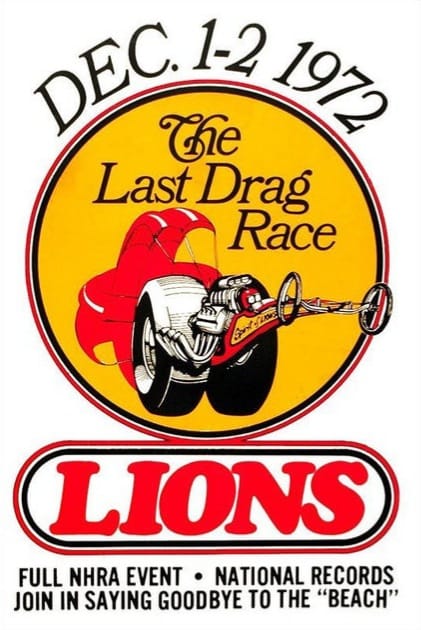
There is some irony in how The Last Drag Race went down. On opening day in 1955, Mickey Thompson and his volunteer staff were not sure what to expect and were prepared to host 2500 people at the track. When 10,000 plus showed up, the spectators were not thrilled about long waits to get tickets and simply tore down the fencing and let themselves in. After suffering dust, over flowing toilets, food shortages and water shortages, the fans crowded right out on to the track to watch the racing. It was mayhem to say the least.

Fast forward to December 2nd, 1972 and what you have is 20,000 plus showing up at the track to watch The Last Drag Race. Fences were torn down to gain entry, toilets overflowing, a shortage of food, no shortage of pot or booze, and fans coming right out on to the track to watch the action. And there you have the ironic beginning and end to one of the greatest drag strips the country has ever seen.
The build up to The Last Drag Race spans 17 years. Mickey Thompson and his showmanship created a legendary track. After Mickey left and CJ Hart came in, he had early success as the operator of the track however his success started to wane and tracks popularity took a hit by the end of the 60s and into the early 70s. Most of the problems were due to noise issues with the track and also CJ’s lack of understanding of the new Funny Car class. CJ had to deal with a less than enthusiastic Lions Board of Directors and the Harbor Commission who did not want him running more top fuel events specifically because of the noise issues which were a result of urban sprawl.
Steve Evans took over the day to day operations of the track in the early 70s and renovated the track. The schedule of events increased and so did the noise issues. In 1972 Steve managed to get the NHRA to sanction The Grand Premiere.

The Grand Premiere ended up being one of the most successful events that Lions ever held and 1972 was also the most successful year in the tracks 17 years of operation. The track turned over $70,000 to the Lions charity fund that year alone. Lions was once again living up to the legend it had created as the quickest and fastest drag strip in the country. Crowds were back and entries for jr. fuel and grudge races were up. Then the hammer dropped.
Using the 30 day revocation clause, the Harbor Commission revoked Lions lease. The reason stated was… “noise complaints”. The reality was much different. The Harbor Commission wanted the land to expand the harbor district. Instead of great drag racing the land would now host warehouses to import foreign goods. There was a limited attempt to lobby city hall to keep the track open but the closing date was set. December 2nd, 1972 would end an era in Southern California. An era that saw the building of superstars, legends and an entire industry dedicated to going quicker and faster. The closing of Lions had a profound effect on the direction and look of the sport of drag racing. Like Woodstock, The Last Drag Race was the peak and also the end of a cultural era that saw the free spirit of people create great things in America. Without this era in American history, Niel Armstrong would not have walked on the moon, The Beatles wouldn’t have been the huge success they were, The Civil Rights Act would not have been passed and drag racing would not have become the huge national sport that it is.
December 2nd, 1972.
This is a day that is hard to describe. I have asked many people who were there to describe the event and most respond with a one word answer. Don Ewald- “sureal”, Herm Petersen- “a happening”, Steve Reyes-“out of control”, Gary Beck-“it was something!”. To try to describe the events that took place the evening of December 2nd 1972 is really not possible. Most people who were there simply smile as they look into their minds eye and say something like “awesome”. Carl Olson has talked with me several times about The Last Drag Race and each time he gives different details about the race, the fans, and the atmosphere. My conclusion, as a person who was not there, is that it was impossible to understand the total scope of the event from one perspective. As I have talked to many people about the event, I have put together a rough sketch of what really went down.
To start the evening off, the line of cars trying to get into Lions clogged up streets and freeways and caused the police to close the gates at some point believing that track was at capacity. This did not deter the hard core fans as they stormed the fences and tore them down to gain entry. Racers came from long distances to race The Last Drag Race because of the $5000 prize Cragar was offering to the first racer to break the 5 second barrier at Lions. They also wanted to be at Lions for The Last Drag Race because of the legend of the track. Remember the change in wind I mentioned earlier? The usually dense air coming off the ocean was not present and trying to reach the coveted 5 second mark was almost out of the question. The fans came expecting to see that barrier broken at The Last Drag Race and the racers had every intention of giving the fans what they wanted. Even though Don Moody qualified at 6.04 on December 1st, the evening of December 2nd the air wasn’t going to give up that 5 second run.
Round one of top fuel was as expected. Exciting and event filled. The fans that had already lined up along the top end of the track were showered with flying debris as Gary Beck exploded in the lights. Shortly after that, Dennis Baca made a single run at 6.14. Clearly these guys were trying their best to land the $5000 prize from Cragar.
Once round one of top fuel was over, the fans were sufficiently stoned and boozed up to begin the decent into mayhem. With many carrying in their own fireworks, the periods in between rounds and races began to look like a 4th of July fireworks display including lighting up tumble weeds causing a fire that in some cases shot 50 feet into the nigh sky. By the time the first round of Funny Car started, hundreds of fans had jumped the fences and lined both sides of the track.
There has been a lot of speculation about the lack of response by security but I believe they were worried about causing a riot if they stepped in to stop what was going on so the people were left to stand right where they were. I remember reading a quote from Hot Rod magazine about the level of pot smoke in the air. “The pungent odor of marijuana hung heavy over the track, overpowering even the nitro fumes belching from the staged Funny Cars.” During the first Round of Funny Car, Steve Evans made an announcement over the PA: “Roger Chandler, meet your wife behind the timing tower. It’s a medical emergency. Your wife is having a baby. The labor pains are coming every three or four minutes.”


The show went on in typical nos-stop Lions fashion. Top Fuel, Funny Car, Injected Funny Cars, Pro Stock, Stock Eliminator and “Wild Bill” had his wheel stander there to entertain in between rounds. During round two, Jeb Allen, Carl Olson, Don Moody and Mike Snively won. Moody and Snively both ran 6.15s and fans were hopeful that they would see the 5 second run by the end of the night. Don Moody was back in the show on “the break rule”. He was actually defeated in round one by Gary Beck who shot gunned his engine and was unable to continue. Funny Car saw victories by Goose, Jim Dunn, Snake, and Billy Meyer.
The semi final rounds didn’t begin until after midnight so you can imagine the state the spectators were in by this point. More and more of them went over the fences and stood along the edge of the track. Then came a very strange moment. Don Moody ran a 6.02 and defeated Jeb Allen to earn the right to compete in the final. Carl Olson of the Kuhl and Olson team beat Snively to earn a trip to the final as well. Now the strange part! While on the return road, Don Moody and his team were showered with cans, bottles and obscenities as a result of not breaking the 5 second barrier. When they finally reached their pit the decision was made to pull the plug and get the hell out of there before the crowd erupted into total anarchy. They packed up and left. Because of this, Jeb Allen was advanced to the final round on the “break rule”. That was not the end of strange happenings in the semi final round. In Funny Car, Goose beat Jim Dunn and then came another strange moment. Billy Meyer and his crew frantically tried to replace a clutch in between rounds and couldn’t get the job done in time.

As a result Carruthers was brought back in to race Snake. Burnouts were done and both were preparing to stage when Billy Meyer showed up on the starting line with his car lit and ready to run. His crew tried in vein to wave off Carruthers but it was too late. Snake went on to beat Carruthers and set up a most appropriate final round in Funny Car between Snake and Mongoose. Mongoose won the final and set the stage for Top Fuel.
After Steve Evans picked up the PA microphone and asked the people trying to take apart the guard rail to wait until the last round was over, the air hung still and thick with anticipation. The crowd was actually silent and the evening air pulsed with an electric feel. This was it. The last Top Eliminator at Lions. Carl Olson and Jeb Allen were on the rollers and just waiting for the signal to fire up. Once the signal was given by Larry Sutton, they both fired and did the last burnout the track would ever see. Carl Olson explained to me that he wasn’t sure if he would be able to make it to the starting line because the crowd of people had closed in and he was afraid he would run someone over. Somehow, Larry Sutton and his crew managed to clear the lanes.
Carl and Jeb then staged and were ready for their last trip down Lions drag strip. I have tried to imagine the scene in my mind many times. I may romanticize it a bit but I picture the crowd taking a deep breath and holding it. Eyes fixed on the tree. Nitro fumes and fog heavy in the air. The light goes green and they are gone. Side by side all the way to the finish line screaming past hundreds of people standing along the track….. Carl Olson taking the win by a wink at 6.20.
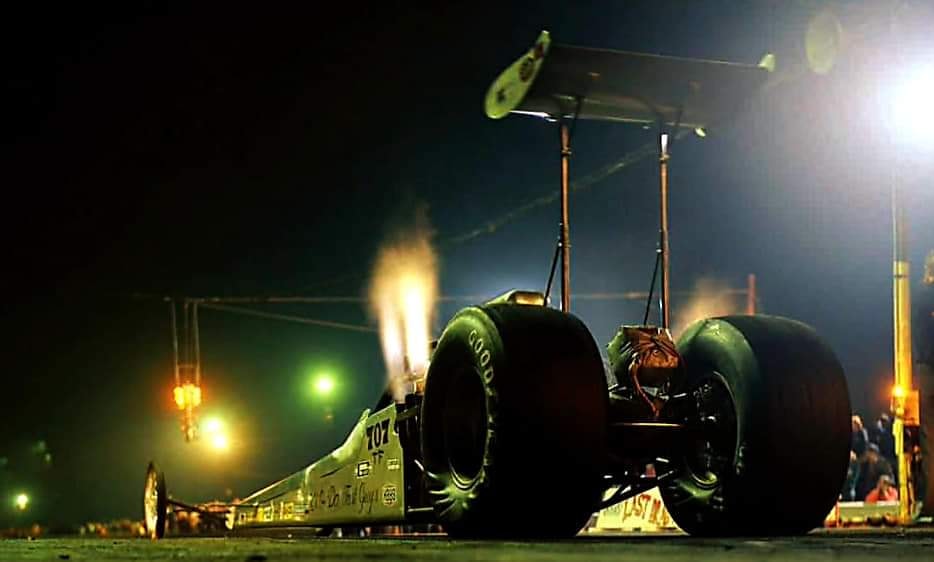
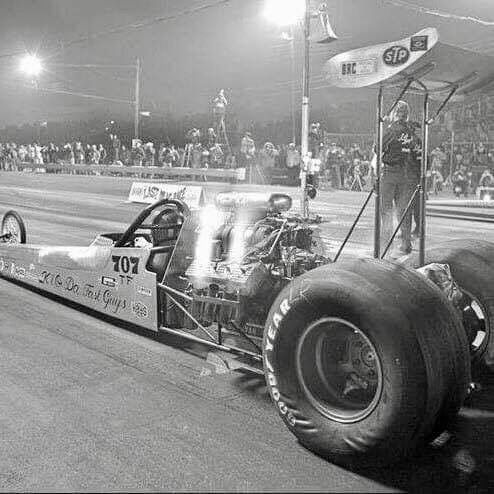
And then…all hell breaks loose. People tear the place apart trying to take home their piece of the Lions Drag Strip. The signs, the guard rails, the bleachers and any other thing people could get their hands on came down and were loaded into cars.
Pick axes came out and chunks of asphalt were torn out. Larry Sutton took a 60 mph trip in a porta-poti being dragged behind a truck down the drag strip. I wonder, does that make Larry Sutton the last to make a run down the drag strip.
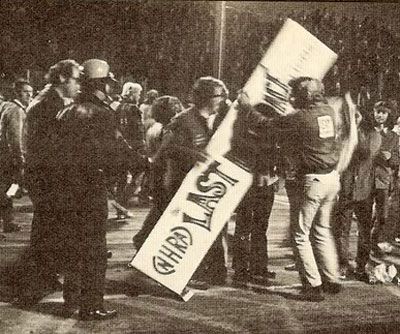
As the Sun came up on December 3rd, the story of Lions Drag Strip came to an end. Carl Olson was trying to comprehend what had just happened and Lions looked like a bomb went off. Carl has told me on several occasions that he has never really been able to put words to the emotions that surround the victory at The Last Drag Race. Although Carl had other more significant victories in his career as a Top Fuel driver, he has said that none surpassed the emotional victory he gained from being the last winner of The Last Drag Race at Lions Drag Strip.

Today cars pass the site of Lions Drag Strip on the freeway and very few ever look over hoping to see the track. Most people don’t know there was ever a drag strip there. We who love this sport remember! We will never forget the legacy of Lions and what that track meant to the sport and to a generation of drag racers. So many of the greatest drag racers of that era grew up at that track. Many good friends, husbands, uncles, brothers and competitors lost their lives at that track in pursuit of the quicker or faster run. Many lucrative careers were built at Lions. But the biggest take away from the closing of Lions is that an era had come to an end. It wasn’t just a drag racing era but a cultural era. The 60s were over and so was the era of the free spirit. The 70s were a time of transition in drag racing and in America in general. There would never again be teams of drag racers like The Surfers, just to name one. For those of us who were never able to attend a race at Lions all we can do is try to understand through the eyes of others and for that I am grateful for Carl Olson, Herman Petersen, Don Ewald, Gary Beck, and Steve Reyes in particular. They have allowed me to be a part of something that I was too young to understand or participate in. As the memory fades on Lions and many of the people who raced there are lost, it is up to all of us as a community of fans to help the memory live on. Long live Lions!
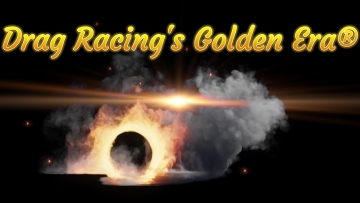
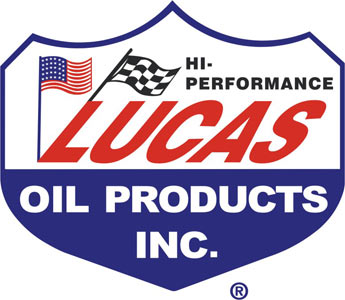


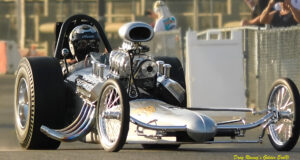
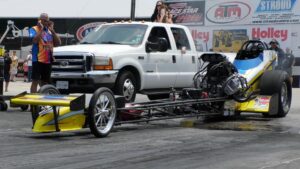
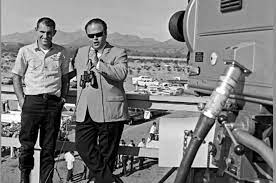

More Stories
Nitro Revival 6: Full Coverage
Nostalgia Top Fuel
7.0 and 7.5 Racing at Bowling Green